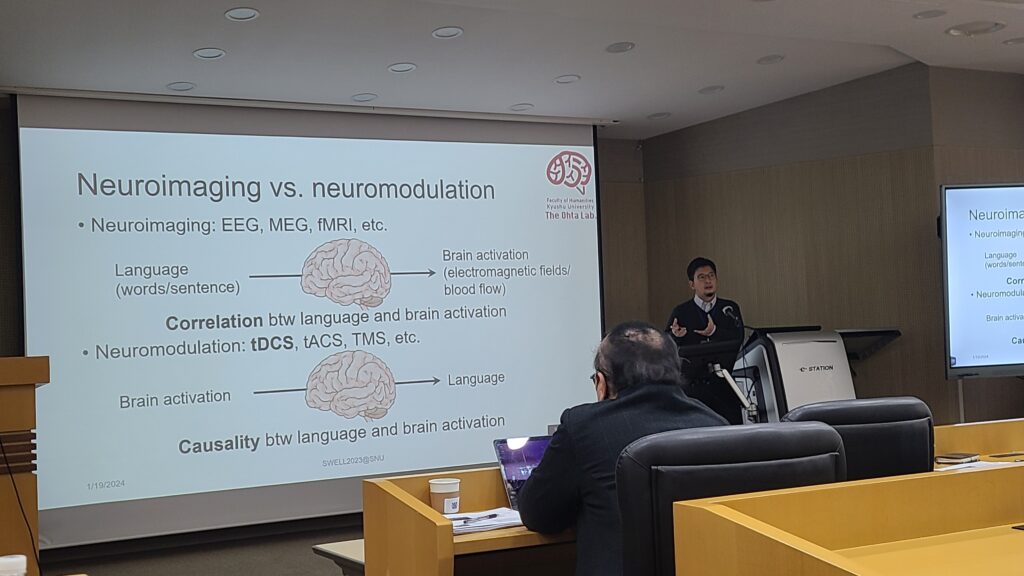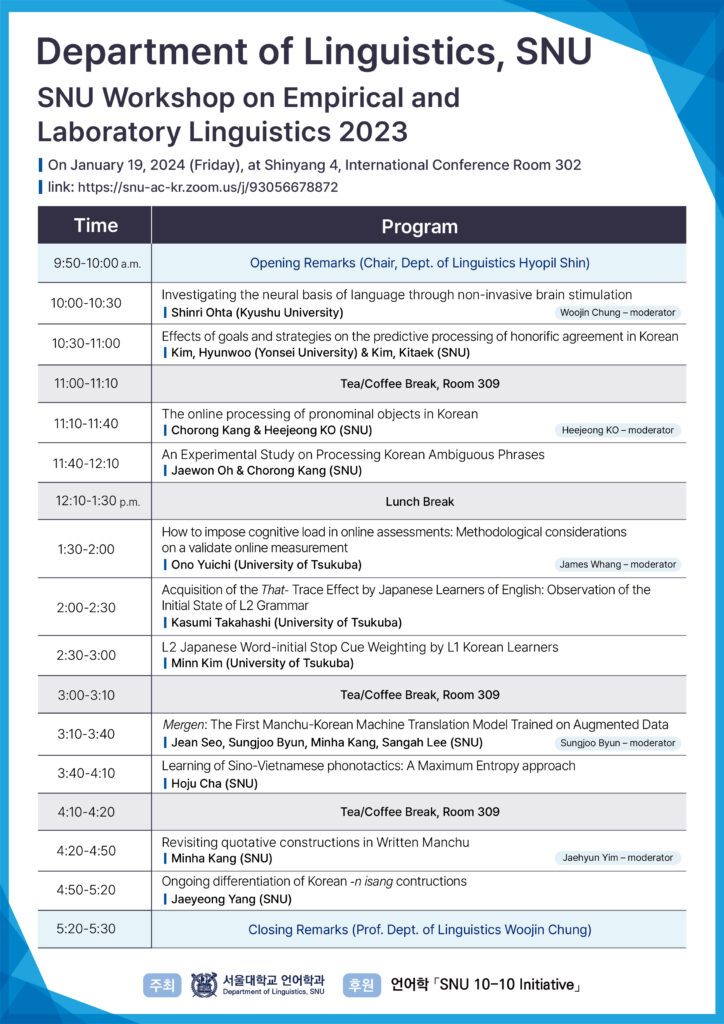SWELL2023
2024年1月19日(金)にソウル大学校言語学科で開催されるSNU Workshop on Empirical and Laboratory Linguistics 2023 (SWELL2023) にて、太田が下記の招待講演を行いました。
 演題:Investigating the neural basis of language through non-invasive brain stimulation
演題:Investigating the neural basis of language through non-invasive brain stimulation
発表者:Shinri OHTA (Kyushu University)
要旨: While most of the previous neuroimaging research has provided correlational evidence linking the left inferior frontal gyrus (LIFG) to language processing, the causal role of the LIFG in language processing has remained uninvestigated. We applied high-definition transcranial direct current stimulation (HD-tDCS) over the LIFG during a second language (L2) grammar acquisition task using Spanish verb conjugations to elucidate such a causal role.
We recruited 28 and 50 native Japanese speakers, who were naïve to Spanish, for behavioral (Experiment 1) and electroencephalography (EEG) experiments (Experiment 2), respectively. In both experiments, participants completed a 20-minute training of regular present-tense verb conjugations for the three Spanish verb types (-ar, -er, -ir). We applied 20-minute anodal (i.e., excitatory) HD-tDCS or sham stimulation over the left IFG during a training phase. Half of the participants received active HD-tDCS (the active group), while the other half received sham stimulation (the sham group).
In Experiment I, participants completed a visual task phase consisting of two linguistic tasks (a receptive grammaticality-judgment task and a productive verb-conjugation task) and a non-linguistic working memory task (remembering six Spanish verbs) as a control task. The reception task required participants to identify whether a given verb was conjugated correctly according to the given subject pronoun. In contrast, the production task required the participants to verbalize the correct conjugation when given a subject pronoun and an unconjugated verb. This procedure was repeated in three separate sessions at one-week intervals. A three-way repeated measures ANOVA (stimulation x task x session) was carried out for accuracy and reaction time (RT). We found a significant facilitatory effect of stimulation on the reception task in the first and third sessions and on the production task in the first session, but not on the working memory task. Similarly, we found that stimulation had a significant facilitatory effect on RT in the reception task in each session and in the production task in the second and third sessions. These results demonstrated that HD-tDCS over the LIFG significantly improved L2 acquisition but not working memory.
In Experiment 2, participants completed an auditory task phase consisting of two linguistic tasks and two non-linguistic working-memory tasks (remembering the gender of auditory voice stimuli and the order of animal calls). EEG data were recorded during the receptive linguistic task and aligned to the critical syllable onset (i.e., the syllable of conjugation disambiguation) to assess the neurophysiological effects of stimulation on L2 acquisition. Due to the exploratory nature of this study, we first visually inspected whole-epoch (0—2000 ms) topographical maps of both groups to select regions and time windows of interest for event-related potentials (ERPs). While the two groups had similar ERPs, the anodal group exhibited smaller and shorter-lasting potentials, indicating that anodal stimulation over the LIFG improved cognitive efficiency. Additional tests for correlations between accuracy and ERP amplitude revealed that the active group exhibited a reversal of the sham group’s positive correlation over left frontotemporal electrodes. That is, in the sham group, as accuracy improved, left frontotemporal ERPs became stronger and more positive, while in the active group, improvements in accuracy were characterized by weaker and more negative deflections.
Behavioral data showed that HD-tDCS over the LIFG improves L2 grammar acquisition. Meanwhile, ERP results indicated improved cognitive efficiency and a reversal of the correlation between accuracy and left frontotemporal ERP amplitude. These results suggest that HD-tDCS over the LIFG during L2 grammar acquisition caused the active group to more quickly reach a later stage of language learning (e.g., the consolidation phase), while the sham group remained at an earlier stage (e.g., shallow learning phase), demonstrating a causal relationship between the LIFG and L2 acquisition.


